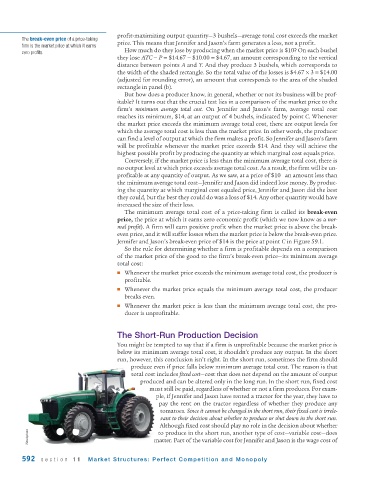Page 634 - Krugmans Economics for AP Text Book_Neat
P. 634
profit-maximizing output quantity—3 bushels—average total cost exceeds the market
The break-even price of a price-taking
price. This means that Jennifer and Jason’s farm generates a loss, not a profit.
firm is the market price at which it earns
How much do they lose by producing when the market price is $10? On each bushel
zero profits.
they lose ATC − P = $14.67 − $10.00 = $4.67, an amount corresponding to the vertical
distance between points A and Y. And they produce 3 bushels, which corresponds to
the width of the shaded rectangle. So the total value of the losses is $4.67 × 3 = $14.00
(adjusted for rounding error), an amount that corresponds to the area of the shaded
rectangle in panel (b).
But how does a producer know, in general, whether or not its business will be prof-
itable? It turns out that the crucial test lies in a comparison of the market price to the
firm’s minimum average total cost. On Jennifer and Jason’s farm, average total cost
reaches its minimum, $14, at an output of 4 bushels, indicated by point C. Whenever
the market price exceeds the minimum average total cost, there are output levels for
which the average total cost is less than the market price. In other words, the producer
can find a level of output at which the firm makes a profit. So Jennifer and Jason’s farm
will be profitable whenever the market price exceeds $14. And they will achieve the
highest possible profit by producing the quantity at which marginal cost equals price.
Conversely, if the market price is less than the minimum average total cost, there is
no output level at which price exceeds average total cost. As a result, the firm will be un-
profitable at any quantity of output. As we saw, at a price of $10—an amount less than
the minimum average total cost—Jennifer and Jason did indeed lose money. By produc-
ing the quantity at which marginal cost equaled price, Jennifer and Jason did the best
they could, but the best they could do was a loss of $14. Any other quantity would have
increased the size of their loss.
The minimum average total cost of a price-taking firm is called its break-even
price, the price at which it earns zero economic profit (which we now know as a nor-
mal profit). A firm will earn positive profit when the market price is above the break-
even price, and it will suffer losses when the market price is below the break-even price.
Jennifer and Jason’s break-even price of $14 is the price at point C in Figure 59.1.
So the rule for determining whether a firm is profitable depends on a comparison
of the market price of the good to the firm’s break-even price—its minimum average
total cost:
■ Whenever the market price exceeds the minimum average total cost, the producer is
profitable.
■ Whenever the market price equals the minimum average total cost, the producer
breaks even.
■ Whenever the market price is less than the minimum average total cost, the pro-
ducer is unprofitable.
The Short-Run Production Decision
You might be tempted to say that if a firm is unprofitable because the market price is
below its minimum average total cost, it shouldn’t produce any output. In the short
run, however, this conclusion isn’t right. In the short run, sometimes the firm should
produce even if price falls below minimum average total cost. The reason is that
total cost includes fixed cost—cost that does not depend on the amount of output
produced and can be altered only in the long run. In the short run, fixed cost
must still be paid, regardless of whether or not a firm produces. For exam-
ple, if Jennifer and Jason have rented a tractor for the year, they have to
pay the rent on the tractor regardless of whether they produce any
tomatoes. Since it cannot be changed in the short run, their fixed cost is irrele-
vant to their decision about whether to produce or shut down in the short run.
Although fixed cost should play no role in the decision about whether
iStockphoto matter. Part of the variable cost for Jennifer and Jason is the wage cost of
to produce in the short run, another type of cost—variable cost—does
592 section 11 Market Structures: Perfect Competition and Monopoly

